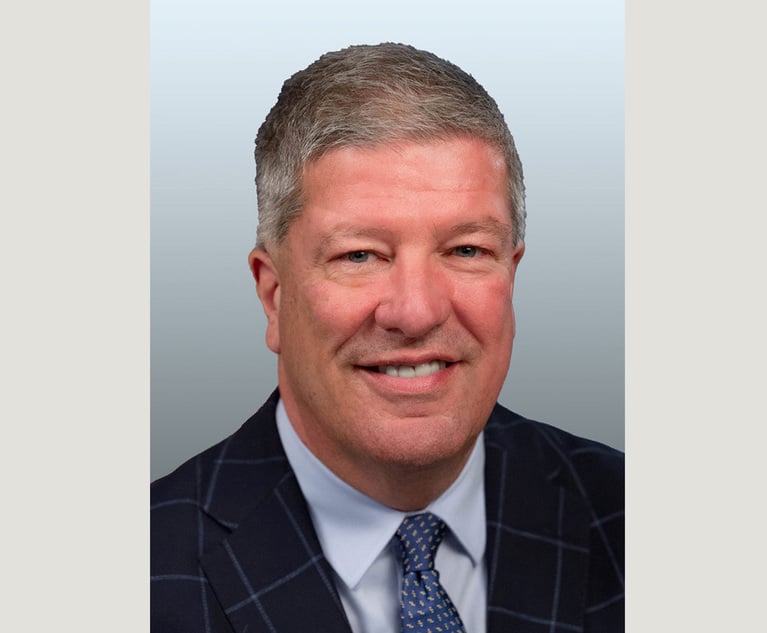What to Expect When You're Expecting OSHA to Visit Your Reopened Workplace
On May 19, OSHA issued two enforcement memos outlining its plans to inspect workplaces during the COVID-19 pandemic. These memos took effect on May 26.
June 04, 2020 at 12:49 PM
4 minute read
 Brian D. Lipkin, Babst Calland
Brian D. Lipkin, Babst Calland
The Occupational Safety and Health Administration (OSHA) is the federal agency that enforces workplace safety and health rules. On May 19, OSHA issued two enforcement memos outlining its plans to inspect workplaces during the COVID-19 pandemic. These memos took effect on May 26.
As workplaces reopen, here is what employers can expect:
- High Exposure Workplace Inspections
When employees go back to work, OSHA anticipates an influx of COVID-19-related complaints. As a result, OSHA will prioritize inspections of workplaces with "high" and "very high" risks of COVID-19 exposure, including medical facilities, nursing homes and clinical laboratories.
OSHA is less likely to visit workplaces with medium- and low-risk levels, meaning that employees have less frequent and less close contact with the public. So, retail stores and offices are unlikely to have an OSHA compliance officer pay a visit. If OSHA receives a complaint about a medium- or low-risk workplace, it will typically send a letter, ask the employer to respond in writing and close the inspection without any in-person contact.
- Allowances for Unavailable Equipment
OSHA requires all businesses to provide workers with personal protective equipment. Depending on the type of workplace, equipment to protect against COVID-19 can include masks, gloves and hand sanitizer.
Having shopped at Target recently, OSHA compliance officers understand many businesses can't purchase these items because they are in limited supply. OSHA will use its discretion in citing employers that have acted in good faith, so employers should document their attempts to purchase any equipment that is unavailable.
If a business can't purchase the right protective equipment, it should consider changing workplace rules to limit exposure risks. For example, capacity controls or schedule changes could limit the number of people who come close into close contact with each other.
Next, the enforcement memos suggest that businesses should consider the pros and cons of using any expired equipment they may have. As a last resort, businesses can consider improvising with the protective equipment they are able to obtain.
- Recordkeeping Requirements
As part of an inspection, OSHA is likely to ask employers for written records. For example, OSHA requires all employers to conduct a "hazard assessment," which involves deciding whether the workplace presents risks which require employees to use personal protective equipment. OSHA also requires employers to document in writing that they have done this assessment. Employers may need to update hazard assessments to take into account COVID-19 risks, and should document any changes.
Employers should also be prepared to share with OSHA any policies and training materials relating to COVID-19. When employers provide training, it is a best practice to create a sign-in sheet documenting the name and date of each employee's session.
Finally, OSHA requires certain employers to keep an OSHA 300 Log listing work-related injuries and illnesses. (Employers with 10 or fewer employees, and employers in certain low-risk industries, are exempt from this requirement.) In deciding whether an illness is work-related, the employer must consider whether an exposure in the workplace caused or contributed to the condition. While this standard might seem straightforward, it can be difficult or impossible to identify how an employee contracts COVID-19, leading employers to be uncertain about how they should report these illnesses.
In its enforcement memos, OSHA clarifies that if an employee gets the COVID-19 virus, the employer does not need to "undertake extensive medical inquiries" to determine whether to report the illness on its OSHA 300 Log. Instead, the employer should use common sense to evaluate the most likely source of infection. For instance, if an employee does not have frequent contact with the general public, and was the only employee in the workplace with COVID-19, the transmission probably occurred outside of work, and likely would not need to be reported.
- Next Steps
Now is the best time for employers to prepare for a potential OSHA inspection. Based on these enforcement memos, we expect OSHA to prioritize inspections of high-risk workplaces, require employers to use good faith to obtain appropriate protective equipment, and request records showing efforts to limit COVID-19 risks.
For the latest updates on OSHA's response to COVID-19, employers can visit OSHA's website at osha.gov/covid-19.
Brian D. Lipkin is an associate with the Pittsburgh law firm of Babst Calland Clements & Zomnir. He represents employers in workplace safety and health matters. Contact him at 412-394-5456 or [email protected].
This content has been archived. It is available through our partners, LexisNexis® and Bloomberg Law.
To view this content, please continue to their sites.
Not a Lexis Subscriber?
Subscribe Now
Not a Bloomberg Law Subscriber?
Subscribe Now
NOT FOR REPRINT
© 2025 ALM Global, LLC, All Rights Reserved. Request academic re-use from www.copyright.com. All other uses, submit a request to [email protected]. For more information visit Asset & Logo Licensing.
You Might Like
View All
Stevens & Lee Hires Ex-Middle District of Pennsylvania U.S. Attorney as White-Collar Co-Chair
3 minute read
Judge Tanks Prevailing Pittsburgh Attorneys' $2.45M Fee Request to $250K
5 minute read
Law Firms Mentioned
Trending Stories
- 1Delaware Supreme Court Names Civil Litigator to Serve as New Chief Disciplinary Counsel
- 2Inside Track: Why Relentless Self-Promoters Need Not Apply for GC Posts
- 3Fresh lawsuit hits Oregon city at the heart of Supreme Court ruling on homeless encampments
- 4Ex-Kline & Specter Associate Drops Lawsuit Against the Firm
- 5Am Law 100 Lateral Partner Hiring Rose in 2024: Report
Who Got The Work
J. Brugh Lower of Gibbons has entered an appearance for industrial equipment supplier Devco Corporation in a pending trademark infringement lawsuit. The suit, accusing the defendant of selling knock-off Graco products, was filed Dec. 18 in New Jersey District Court by Rivkin Radler on behalf of Graco Inc. and Graco Minnesota. The case, assigned to U.S. District Judge Zahid N. Quraishi, is 3:24-cv-11294, Graco Inc. et al v. Devco Corporation.
Who Got The Work
Rebecca Maller-Stein and Kent A. Yalowitz of Arnold & Porter Kaye Scholer have entered their appearances for Hanaco Venture Capital and its executives, Lior Prosor and David Frankel, in a pending securities lawsuit. The action, filed on Dec. 24 in New York Southern District Court by Zell, Aron & Co. on behalf of Goldeneye Advisors, accuses the defendants of negligently and fraudulently managing the plaintiff's $1 million investment. The case, assigned to U.S. District Judge Vernon S. Broderick, is 1:24-cv-09918, Goldeneye Advisors, LLC v. Hanaco Venture Capital, Ltd. et al.
Who Got The Work
Attorneys from A&O Shearman has stepped in as defense counsel for Toronto-Dominion Bank and other defendants in a pending securities class action. The suit, filed Dec. 11 in New York Southern District Court by Bleichmar Fonti & Auld, accuses the defendants of concealing the bank's 'pervasive' deficiencies in regards to its compliance with the Bank Secrecy Act and the quality of its anti-money laundering controls. The case, assigned to U.S. District Judge Arun Subramanian, is 1:24-cv-09445, Gonzalez v. The Toronto-Dominion Bank et al.
Who Got The Work
Crown Castle International, a Pennsylvania company providing shared communications infrastructure, has turned to Luke D. Wolf of Gordon Rees Scully Mansukhani to fend off a pending breach-of-contract lawsuit. The court action, filed Nov. 25 in Michigan Eastern District Court by Hooper Hathaway PC on behalf of The Town Residences LLC, accuses Crown Castle of failing to transfer approximately $30,000 in utility payments from T-Mobile in breach of a roof-top lease and assignment agreement. The case, assigned to U.S. District Judge Susan K. Declercq, is 2:24-cv-13131, The Town Residences LLC v. T-Mobile US, Inc. et al.
Who Got The Work
Wilfred P. Coronato and Daniel M. Schwartz of McCarter & English have stepped in as defense counsel to Electrolux Home Products Inc. in a pending product liability lawsuit. The court action, filed Nov. 26 in New York Eastern District Court by Poulos Lopiccolo PC and Nagel Rice LLP on behalf of David Stern, alleges that the defendant's refrigerators’ drawers and shelving repeatedly break and fall apart within months after purchase. The case, assigned to U.S. District Judge Joan M. Azrack, is 2:24-cv-08204, Stern v. Electrolux Home Products, Inc.
Featured Firms
Law Offices of Gary Martin Hays & Associates, P.C.
(470) 294-1674
Law Offices of Mark E. Salomone
(857) 444-6468
Smith & Hassler
(713) 739-1250






